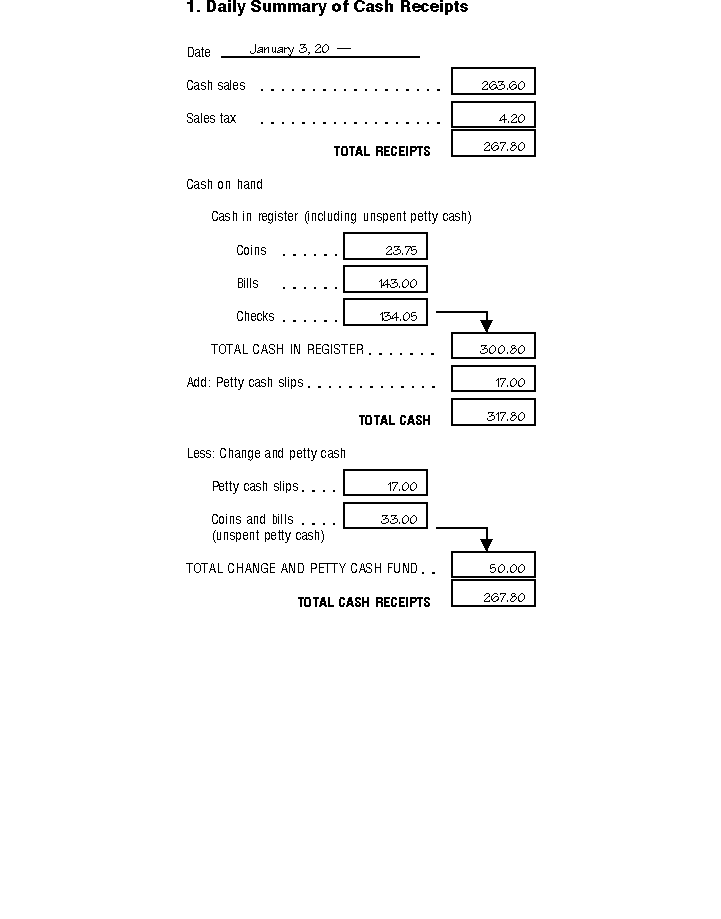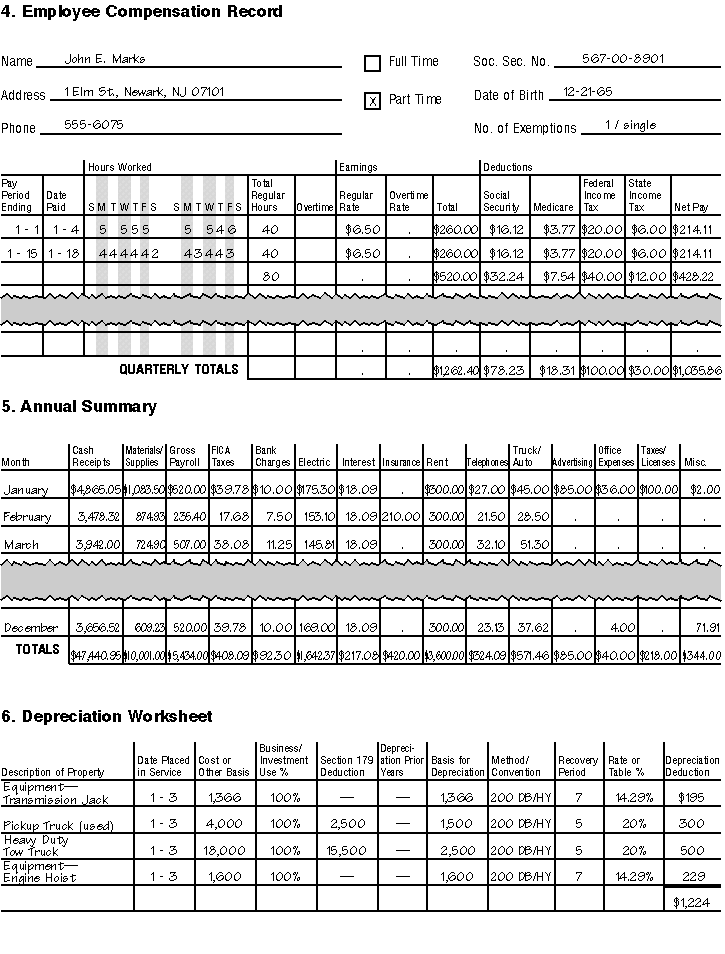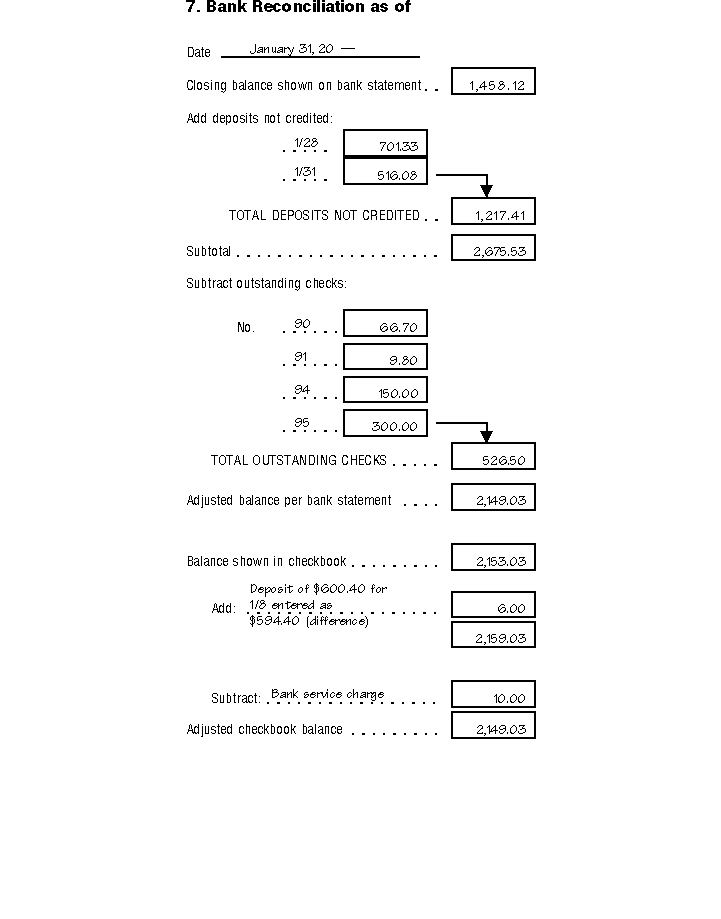 |
2002 Tax Help Archives |
Computerized System There are computer software packages you can use for recordkeeping. They can be purchased in many retail stores. These packages are very useful and relatively easy to use; they require very little knowledge of bookkeeping and accounting. If you use a computerized system, you must be able to produce sufficient legible records to support and verify entries made on your return and determine your correct tax liability. To meet this qualification, the machine-sensible records must reconcile with your books and return. These records must provide enough detail to identify the underlying source documents. You must also keep all machine-sensible records and a complete description of the computerized portion of your recordkeeping system. This documentation must be sufficiently detailed to show all of the following items.
See Revenue Procedure 98-25 in Cumulative Bulletin 1998-1 for more information. Microfilm Microfilm and microfiche reproductions of general books of accounts, such as cash books, journals, voucher registers, and ledgers, are accepted for recordkeeping purposes if they comply with Revenue Procedure 81-46 in Cumulative Bulletin 1981-2. Electronic Storage System Records maintained in an electronic storage system are accepted for recordkeeping purposes if the system complies with Revenue Procedure 97-22 in Cumulative Bulletin 1997-1. An electronic storage system is one that either images hardcopy (paper) books and records or transfers computerized books and records to an electronic storage media, such as an optical disk. How Long To Keep Records You must keep your records as long as they may be needed for the administration of any provision of the Internal Revenue Code. Generally, this means you must keep records that support an item of income or deduction on a return until the period of limitations for that return runs out. The period of limitations is the period of time in which you can amend your return to claim a credit or refund, or the IRS can assess additional tax. Table 3 on page 15 contains the periods of limitations that apply to income tax returns. Unless otherwise stated, the years refer to the period after the return was filed. Returns filed before the due date are treated as filed on the due date.
Employment taxes. If you have employees, you must keep all employment tax records for at least 4 years after the date the tax becomes due or is paid, whichever is later. Assets. Keep records relating to property until the period of limitations expires for the year in which you dispose of the property in a taxable disposition. You must keep these records to figure any depreciation, amortization, or depletion deduction, and to figure your basis for computing gain or loss when you sell or otherwise dispose of the property. Generally, if you received property in a nontaxable exchange, your basis in that property is the same as the basis of the property you gave up, increased by money you paid. You must keep the records on the old property, as well as on the new property, until the period of limitations expires for the year in which you dispose of the new property in a taxable disposition. Records for nontax purposes. When your records are no longer needed for tax purposes, do not discard them until you check to see if you have to keep them longer for other purposes. For example, your insurance company or creditors may require you to keep them longer than the IRS does. Sample Record System This example illustrates a single-entry system used by Henry M. Brown, who is the sole proprietor of a small automobile body shop. Henry uses part-time help, has no inventory of items held for sale, and uses the cash method of accounting. These sample records should not be viewed as a recommendation of how to keep your records. They are intended only to show how one business keeps its records. 1. Daily Summary of Cash Receipts This summary is a record of cash sales for the day. It accounts for cash at the end of the day over the amount in the Change and Petty Cash Fund at the beginning of the day. Henry takes the cash sales entry from his cash register tape. If he had no cash register, he would simply total his cash sale slips and any other cash received that day. He carries the total receipts shown in this summary for January 3 ($267.80), including cash sales ($263.60) and sales tax ($4.20), to the Monthly Summary of Cash Receipts. Petty cash fund. Henry uses a petty cash fund to make small payments without having to write checks for small amounts. Each time he makes a payment from this fund, he makes out a petty cash slip and attaches it to his receipt as proof of payment. He sets up a fixed amount ($50) in his petty cash fund. The total of the unspent petty cash and the amounts on the petty cash slips should equal the fixed amount of the fund. When the totals on the petty cash slips approach the fixed amount, he brings the cash in the fund back to the fixed amount by writing a check to Petty Cash for the total of the outstanding slips. (See the Check Disbursements Journal entry for check number 92.) This restores the fund to its fixed amount of $50. He then summarizes the slips and enters them in the proper columns in the monthly check disbursements journal. 2. Monthly Summary of Cash Receipts This shows the income activity for the month. Henry carries the total monthly net sales shown in this summary for January ($4,865.05) to his Annual Summary. To figure total monthly net sales, Henry reduces the total monthly receipts by the sales tax imposed on his customers and turned over to the state. He cannot take a deduction for sales tax turned over to the state because he only collected the tax. He does not include the tax in his income. 3. Check Disbursements Journal (Page 20) Henry enters checks drawn on the business checking account in the Check Disbursements Journal each day. All checks are prenumbered and each check number is listed and accounted for in the column provided in the journal. Frequent expenses have their own headings across the sheet. He enters in a separate column expenses that require comparatively numerous or large payments each month, such as materials, gross payroll, and rent. Under the General Accounts column, he enters small expenses that normally have only one or two monthly payments, such as licenses and postage. Henry does not pay personal or nonbusiness expenses by checks drawn on the business account. If he did, he would record them in the journal, even though he could not deduct them as business expenses. Henry carries the January total of expenses for materials ($1,083.50) to the Annual Summary. Similarly, he enters monthly total of expenses for telephone, truck, auto, etc., in the appropriate columns of that summary. 4. Employee Compensation Record This record shows the following information.
Henry carries the January gross payroll ($520) to the Annual Summary. 5. Annual Summary (Page 22) This annual summary of monthly cash receipts and expense totals provides the final amounts to enter on Henry's tax return. He figures the cash receipts total from the total of monthly cash receipts shown in the Monthly Summary of Cash Receipts. He figures the expense totals from the totals of monthly expense items shown in the Check Disbursements Journal. As in the journal, he keeps each major expense in a separate column. Henry carries the cash receipts total shown in the annual summary ($47,440.95) to Part I of Schedule C (not illustrated). He carries the total for materials ($10,001.00) to Part II of Schedule C.
Henry enters annual totals for interest, rent, taxes, and wages on the appropriate lines in Part II of Schedule C. The total for taxes and licenses includes the employer's share of social security and Medicare taxes, and the business license fee. He enters the total of other annual business expenses on the Other expenses line of Schedule C. 6. Depreciation Worksheet (Page 22) This worksheet shows the information used in figuring the depreciation allowed on assets used in Henry's business. Henry figures the depreciation using the modified accelerated cost recovery system (MACRS). He also chooses to deduct $24,000 of the cost of the tow truck purchased and placed in service in his trade or business during the year. This is the section 179 deduction. He also chooses to deduct the special depreciation allowance for the properties that qualify. The allowance is an additional 30% of the property's cost or other basis (after subtracting the section 179 deduction). Depreciation, the section 179 deduction, and the special depreciation allowance are discussed in Publication 946. Henry uses the information in the worksheet to complete Form 4562, Depreciation and Amortization (not illustrated).
7. Bank Reconciliation (Page 23) Henry reconciles his checkbook with his bank statement and prepares a bank reconciliation for January as follows.
The only book adjustment Henry needs to make is to the Check Disbursements Journal for the $10 bank service charge. He does not need to adjust the Monthly Summary of Cash Receipts because he correctly entered the January 8 deposit of $600.40 in that record. How To Get More Information This section describes the help the IRS and other federal agencies offer to taxpayers who operate their own businesses. Internal Revenue Service The following describes assistance provided by the IRS. You can order free publications and forms, ask tax questions, and get more information from the IRS in several ways. By selecting the method that is best for you, you will have quick and easy access to tax help. See Free tax services, later. Contacting your Taxpayer Advocate. If you have attempted to deal with an IRS problem unsuccessfully, you should contact your Taxpayer Advocate. The Taxpayer Advocate represents your interests and concerns within the IRS by protecting your rights and resolving problems that have not been fixed through normal channels. While Taxpayer Advocates cannot change the tax law or make a technical tax decision, they can clear up problems that resulted from previous contacts and ensure that your case is given a complete and impartial review. To contact your Taxpayer Advocate:
For more information, see Publication 1546, The Taxpayer Advocate Service of the IRS. Small Business Tax Education Program. Small business owners and other self-employed individuals can learn about business taxes through a unique partnership between the IRS and local organizations. Through workshops or in-depth tax courses, instructors provide training on starting a business, recordkeeping, preparing business tax returns, self-employment tax issues, and employment taxes. Some courses are offered free as a community service. Courses given by an educational facility may include costs for materials and tuition. Other courses may have a nominal fee to offset administrative costs of sponsoring organizations. For more information about this program, call the IRS Monday through Friday during regular business hours and ask for your Taxpayer Education Coordinator. Check your telephone book for the local number of the IRS office closest to you or you can call 1-800-829-1040. Your Business Tax Kit. Your Business Tax Kit is an assortment of IRS forms and publications to help taxpayers who operate their own businesses. To order the kit, see Free tax services, later. The kit consists of the following items. Forms:
Publications:
Free tax services. To find out what services are available, get Publication 910, Guide to Free Tax Services. It contains a list of free tax publications and an index of tax topics. It also describes other free tax information services, including tax education and assistance programs and a list of TeleTax topics.
You can also reach us with your computer using File Transfer Protocol at ftp.irs.gov.
For help with transmission problems, call the FedWorld Help Desk at 703-487-4608.
Daily summary cash receipts
Employee compensation record, annual summary, and depreciation worksheet
Bank reconciliation
Evaluating the quality of our telephone services. To ensure that IRS representatives give accurate, courteous, and professional answers, we evaluate the quality of our telephone services in several ways.
The CD-ROM can be purchased from National Technical Information Service (NTIS) by calling 1-877- 233-6767 or on the Internet at www.irs.gov. The first release is available in mid-December and the final release is available in late January. IRS Publication 3207, Small Business Resource Guide, is an interactive CD-ROM that contains information important to small businesses. It is available in mid-February. You can get a free copy by calling 1-800-829-3676 or visiting the IRS web site at www.irs.gov. Publication Index | 2002 Tax Help Archives | Tax Help Archives | Home © 2004, UncleFed.com
|
|||||||||||||||||||||||||||||||||||||||||||||||||||||||||||||||||||||||||||||||||||||||||||||||||||||||||||||||||||||||||||||||||||||||||||||||||||||||||||||||||||||||||||||||||||||||||||||||||||||||||||||||||||||||||||||||||||||||||||||||||||||||||||||||||||||||||||||||||||||||||||||||||||||||||||||||||||||||||||||||||||||||||||||||||||||||||||||||||||||||||||||||||||||||||||||||||||||||||||||||||||||||||||||||||||||||||||||||||||||||||||||||||||||||||||||||||||||||||||||||||||||||||||||||||||||||||||||||||||||||||||||||||||||||||||||||||||||||||||||||||||||||||||||||||||||||||||||||||||||||||||||||||||||||||||||||||||||||||||||||||||||||||||||||||||||||||||||||||||||||||||||||||||||||||||||||||||||||||||||||||||||||||||||||||||||||||||||||||||||||||||||||||||||||||||||||||||||||||||||||||||||||||||||||||||||||||||||||||||||||||||||||||||||||||||||||||||||||||||||||||||||||||||||||||||||||||||||||||||||||||||||||||||||||||||||||||||||||||||||||||||||||||||||||||||||||||||||||||||||||
 Printer Friendly Page Printer Friendly Page |

 Keep copies of your filed tax returns. They help in preparing future tax returns and making computations if you later file an amended return.
Keep copies of your filed tax returns. They help in preparing future tax returns and making computations if you later file an amended return.
 A business that keeps materials and supplies on hand generally must complete the inventory lines in Part III of Schedule C. However, there are no
inventories of materials and supplies in this example. Henry buys parts and supplies on a per-job basis; he does not keep them on hand.
A business that keeps materials and supplies on hand generally must complete the inventory lines in Part III of Schedule C. However, there are no
inventories of materials and supplies in this example. Henry buys parts and supplies on a per-job basis; he does not keep them on hand.
 Personal computer. With your personal computer and modem, you can access the IRS on the Internet at www.irs.gov. While
visiting our web site, you can:
Personal computer. With your personal computer and modem, you can access the IRS on the Internet at www.irs.gov. While
visiting our web site, you can:
 TaxFax Service. Using the phone attached to your fax machine, you can receive forms and instructions by calling
703-368-9694. Follow the directions from the prompts. When you order forms, enter the catalog number for the form you need. The
items you request will be faxed to you.
TaxFax Service. Using the phone attached to your fax machine, you can receive forms and instructions by calling
703-368-9694. Follow the directions from the prompts. When you order forms, enter the catalog number for the form you need. The
items you request will be faxed to you.



 Phone. Many services are available by phone.
Phone. Many services are available by phone.
 Walk-in. You can walk in to many post offices, libraries, and IRS offices to pick up certain forms, instructions, and publications. Some
IRS offices, libraries, grocery stores, copy centers, city and county governments, credit unions, and office supply stores have an extensive
collection of products available to print from a CD-ROM or photocopy from reproducible proofs. Also, some IRS offices and libraries have the Internal
Revenue Code, regulations, Internal Revenue Bulletins, and Cumulative Bulletins available for research purposes.
Walk-in. You can walk in to many post offices, libraries, and IRS offices to pick up certain forms, instructions, and publications. Some
IRS offices, libraries, grocery stores, copy centers, city and county governments, credit unions, and office supply stores have an extensive
collection of products available to print from a CD-ROM or photocopy from reproducible proofs. Also, some IRS offices and libraries have the Internal
Revenue Code, regulations, Internal Revenue Bulletins, and Cumulative Bulletins available for research purposes.
 Mail. You can send your order for forms, instructions, and publications to the Distribution Center nearest to you and receive a response
within 10 workdays after your request is received. Find the address that applies to your part of the country.
Mail. You can send your order for forms, instructions, and publications to the Distribution Center nearest to you and receive a response
within 10 workdays after your request is received. Find the address that applies to your part of the country.
 CD-ROM. You can order IRS Publication 1796, Federal Tax Products on CD-ROM, and obtain:
CD-ROM. You can order IRS Publication 1796, Federal Tax Products on CD-ROM, and obtain: